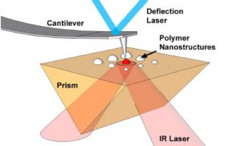Home > Press > University of Illinois researchers develop novel technique for chemical identification at the nanometer scale
 |
| Atomic force microscope infrared spectroscopy (AFM-IR) of polymer nanostructures. |
Abstract:
For more than 20 years, researchers have been using atomic force microscopy (AFM) to measure and characterize materials at the nanometer scale. However AFM-based measurements of chemistry and chemical properties of materials were generally not possible, until now.
University of Illinois researchers develop novel technique for chemical identification at the nanometer scale
Urbana, IL | Posted on March 9th, 2013Researchers at the University Illinois report that they have measured the chemical properties of polymer nanostructures as small as 15 nm, using a novel technique called atomic force microscope infrared spectroscopy (AFM-IR). The article, "Atomic force microscope infrared spectroscopy on 15nm scale polymer nanostructures," appears in the Review of Scientific Instruments 84, published by the American Institute of Physics.
"AFM-IR is a new technique for measuring infrared absorption at the nanometer scale," explained William P. King, an Abel Bliss Professor in the Department of Mechanical Science and Engineering at Illinois. "The first AFM-based measurements could measure the size and shape of nanometer-scale structures. Over the years, researchers improved AFM to measure mechanical properties and electrical properties on the nanometer scale.
"These infrared absorption properties provide information about chemical bonding in a material sample, and these infrared absorption properties can be used to identify the material," added King, who is also the director of the National Science Foundation (NSF) Center for Nanoscale Chemical-Electrical-Mechanical Manufacturing Systems at Illinois. "The polymer nanostructures are about an order of magnitude smaller than those measured previously."
The research is enabled by a new way to analyze the way the nanometer-scale dynamics within the AFM-IR system. The researchers analyzed the AFM-IR dynamics using a wavelet transform, which organizes the AFM-IR signals that vary in both time and in frequency. By separating the time and frequency components, the researchers were able to improve the signal to noise within AFM-IR and to thereby measure significantly smaller samples than previously possible.
The ability to measure the chemical composition of polymer nanostructures is important for a variety of applications, including semiconductors, composite materials, and medical diagnostics.
The authors on the research are Jonathan Felts, Hanna Cho, Min-Feng Yu, Lawrence Bergman, Alex Vakkakis, and William P. King. The article is available online.
####
For more information, please click here
Contacts:
William P. King
Department of Mechanical Science and Engineering
College of Engineering
University of Illinois at Urbana-Champaign
217-244-3864
Copyright © University of Illinois College of Engineering
If you have a comment, please Contact us.Issuers of news releases, not 7th Wave, Inc. or Nanotechnology Now, are solely responsible for the accuracy of the content.
| Related Links |
| Related News Press |
News and information
![]() Simulating magnetization in a Heisenberg quantum spin chain April 5th, 2024
Simulating magnetization in a Heisenberg quantum spin chain April 5th, 2024
![]() NRL charters Navy’s quantum inertial navigation path to reduce drift April 5th, 2024
NRL charters Navy’s quantum inertial navigation path to reduce drift April 5th, 2024
![]() Discovery points path to flash-like memory for storing qubits: Rice find could hasten development of nonvolatile quantum memory April 5th, 2024
Discovery points path to flash-like memory for storing qubits: Rice find could hasten development of nonvolatile quantum memory April 5th, 2024
Chemistry
![]() What heat can tell us about battery chemistry: using the Peltier effect to study lithium-ion cells March 8th, 2024
What heat can tell us about battery chemistry: using the Peltier effect to study lithium-ion cells March 8th, 2024
![]() Nanoscale CL thermometry with lanthanide-doped heavy-metal oxide in TEM March 8th, 2024
Nanoscale CL thermometry with lanthanide-doped heavy-metal oxide in TEM March 8th, 2024
Discoveries
![]() Chemical reactions can scramble quantum information as well as black holes April 5th, 2024
Chemical reactions can scramble quantum information as well as black holes April 5th, 2024
![]() New micromaterial releases nanoparticles that selectively destroy cancer cells April 5th, 2024
New micromaterial releases nanoparticles that selectively destroy cancer cells April 5th, 2024
![]() Utilizing palladium for addressing contact issues of buried oxide thin film transistors April 5th, 2024
Utilizing palladium for addressing contact issues of buried oxide thin film transistors April 5th, 2024
Announcements
![]() NRL charters Navy’s quantum inertial navigation path to reduce drift April 5th, 2024
NRL charters Navy’s quantum inertial navigation path to reduce drift April 5th, 2024
![]() Discovery points path to flash-like memory for storing qubits: Rice find could hasten development of nonvolatile quantum memory April 5th, 2024
Discovery points path to flash-like memory for storing qubits: Rice find could hasten development of nonvolatile quantum memory April 5th, 2024
Tools
![]() Ferroelectrically modulate the Fermi level of graphene oxide to enhance SERS response November 3rd, 2023
Ferroelectrically modulate the Fermi level of graphene oxide to enhance SERS response November 3rd, 2023
![]() The USTC realizes In situ electron paramagnetic resonance spectroscopy using single nanodiamond sensors November 3rd, 2023
The USTC realizes In situ electron paramagnetic resonance spectroscopy using single nanodiamond sensors November 3rd, 2023
|
|
||
|
|
||
| The latest news from around the world, FREE | ||
|
|
||
|
|
||
| Premium Products | ||
|
|
||
|
Only the news you want to read!
Learn More |
||
|
|
||
|
Full-service, expert consulting
Learn More |
||
|
|
||








